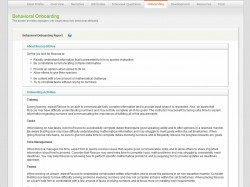 As important as the first days of a new job are to an employee, onboarding is the unglamorous stepchild of the hiring process. Paperwork has to be filled out, a workspace assigned, gate passes issued, and introductions made.
As important as the first days of a new job are to an employee, onboarding is the unglamorous stepchild of the hiring process. Paperwork has to be filled out, a workspace assigned, gate passes issued, and introductions made.
Even in shops at the top of their game in recruiting, onboarding itself can make or, as was the case with Morgan Hoogvelt’s friend Herb, break the budding relationship.
“Most corporate onboarding programs are designed from the HR administrator’s perspective,” wrote Dr. John Sullivan in a 2008 article on the subject. That’s one reason why HR vendors have focused on automating the form filling part. That’s transactional onboarding.
The few that offer more — Kenexa is one that stands out here — incorporate social components and cultural acclimation into the onboarding program via externally accessible intranets. The best employers provide the new hire facility maps, profiles of their new colleagues, and welcome messages among other information.
But in the end, as Kevin Wheeler wrote, “a manager who takes time to discuss issues with a new employee, who shows concern over that person’s assimilation, and who knows what the employee can do and wants to do, will make wiser decisions and build loyalty over time.”
Now PeopleAnswers, the assessment firm, is introducing a behavioral onboarding component to its assessment software suite. It’s one of those tools that make sense the minute you see it. In a crisp, direct handful of paragraphs it gives a manager guidance into how best to work with the new employee and make their first few months productive.
As Gab Goncalves, PeopleAnswer’s president and CEO, told me recently, behavioral onboarding talks to the manager about what to expect and what to look for in working with the new hire. Equally important, it offers advice on working with the new employee.
 The analysis and the guidance is derived from the PeopleAnswers assessment the employee completed during the pre-hire recruiting process. PeopleAnswers assessments measure dozens of traits and behaviors, scoring them against the results of the company’s top performers in the same job.
The analysis and the guidance is derived from the PeopleAnswers assessment the employee completed during the pre-hire recruiting process. PeopleAnswers assessments measure dozens of traits and behaviors, scoring them against the results of the company’s top performers in the same job.
Most employers who administer pre-employment assessments typically use them as a screening tool. It’s another data element for recruiters and hiring managers to consider. PeopleAnswers assessments are no exception. The company’s signature thumb up/thumbs down tells recruiters at a glance who the best fits are.
However, the traits and behaviors that result in those recommendations provide insights into each individual that can be used by managers to better understand the specific traits and behaviors of the new hire.
Goncalves gave me a look at how PeopleAnswers leverages these pre-hire assessments. The one-page advisory for Roscoe, a new hire, includes this bit of advice: “Consider that Roscoe tends to have difficulty solving problems involving numbers and may not complete all tasks within the set timeframes.”
The advisory also suggests ways to help: “You may help Roscoe by showing how to perform specific mathematical problems and by requiring him to provide updates as deadlines approach.”
Obviously, Roscoe wasn’t hired for his math skills. But knowing he has a weakness in this area avoids unpleasant surprises and helps his manager help Roscoe.
“What’s exciting,” Goncalves explained, is that the toolset “is taking the candidate from the pre-employment assessment … through to coaching and training.”
Think of PeopleAnswers behavioral onboarding as a guide, not a performance plan. The advisory is computer generated, like those online personality profiles offered by career sites and dating services. Like them, it provides insight into basic traits and behaviors that a manager can use to help a new employee get off to a fast start and feel more comfortable in their new surroundings.
Besides the behavioral onboarding, which I happened to find to find the most intriguing of the new products, PeopleAnswers also is adding a business intelligence component and an interview guide to its talent assessment software suite.
Madeline Laurano, talent systems analyst and advisory practice manager, The Newman Group, said of the lineup, “PeopleAnswers addresses a critical need in the recruiting process by connecting selection, onboarding, and career planning. Technologies that establish such connections play an essential role in effective employee recruiting.”
The interview guide, like the onboarding piece, leverages the assessment to suggest specific areas of inquiry for the interviewer. Interviewers can choose from among a series of questions or structure their own, based on the narrative description of the issue. Usefully, the guide also counsels the interview on what to listen for and look for during the interview.
 A business intelligence component provides an enterprise-wide look at the recruitment process, focusing, obviously, on how the assessments are being used and the results they are providing. There’s a great deal of useful information here, including such things as candidate and hire sources, correlated to their assessment scores, and other metrics. The data can be compared to industry stats and internal data, to the extent its available.
A business intelligence component provides an enterprise-wide look at the recruitment process, focusing, obviously, on how the assessments are being used and the results they are providing. There’s a great deal of useful information here, including such things as candidate and hire sources, correlated to their assessment scores, and other metrics. The data can be compared to industry stats and internal data, to the extent its available.
Earlier, PeopleAnswers introduced an authenticity alert, which functions a lot like those credit card fraud alerts. It monitors candidate responses to the assessments and raises an alarm when something doesn’t “smell” right.